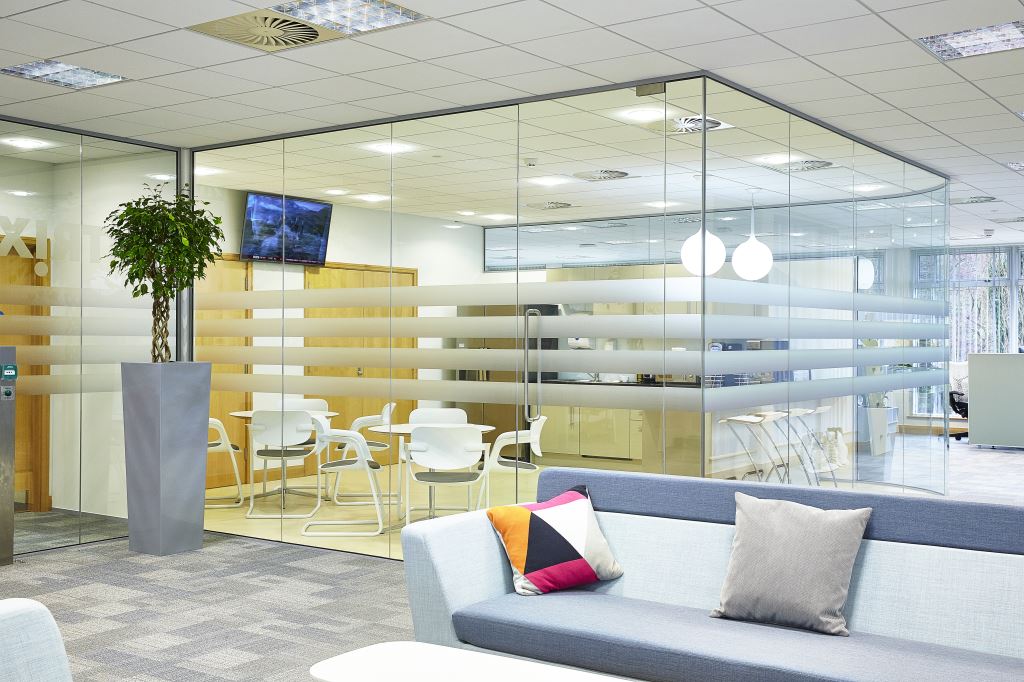Mary Roberts of FIS member iWall talks about the benefits of natural lighting in offices.
Exposure to natural light has been directly linked to greater workplace performance, with the absence of windows positively correlated with workplace stress. A study into the psychological aspects of lighting by B.L. Collins found that 35% of employees instantly identified the absence of natural light as the major concern associated with their office environment, resulting in feelings of isolation, tension and claustrophobia.
In a world increasingly driven by deadlines and targets, greater emphasis than ever is being placed on reducing stress in the workplace. Exposure to natural light has been identified as one of the major sources of psychological comfort and so the windows used in commercial buildings can have a direct impact on productivity.
Creating offices within buildings using a glass partitioning system can be an effective way of maximising natural light. Glass systems, such as the iWall 60 and iWall 110 partitioning system, can be used to provide a flush glass surface by utilising aluminium fittings Due to their stability, these systems allow architects to build entire facades out of glass, enabling design flexibility to create bright and highly attractive working environments, with more light and a greater feeling of space.
Professor Alan Hedge from the Department of Design & Environmental Analysis at Cornell University calculated that workers sitting closer to the window provided a surge in productivity worth $100,000 annually for every 100 workers.
In environments where noise can be a distraction, i Wall offer a high quality acoustic glass that offers excellent noise reduction without compromising on light transmittance. This enables workers to benefit from utmost daylight while avoiding the negative impact of potential noise pollution.
Comfort in the workplace is an ongoing point of focus and the maximisation of natural light can make all the difference when it comes to employee wellbeing.
Flexible working, pet-friendly office policies and things like on-site childcare, nap pods and games rooms are all modern-day work perks which have become the norm. What is a lesser know but equally appealing is having access to plenty of natural light within the working environment.
In fact, Interface’s famous Human Spaces study found that natural light was the number one natural element preferred by 44% of employees when considering workspace design. Aside from giving employees what they want though, what are the main benefits of increasing natural light in the workplace?
A more productive, creative workforce
Improved mood and mental wellness
Daylight has been proven to improve overall mood, energy levels, motivation, positivity and help reduce the effects of SAD – Seasonal Affective Disorder. It also provides a better quality of sleep, which in turn fosters a more energised, engaged and efficient workforce.
Cohere found that those working near a window had around 46 minutes more sleep each night – a statistic backed up by HR advisory firm, Future Workplace as part of ‘The Employee Experience’ study which revealed that daylight working environments presented a 56% reduction in feelings of drowsiness.
Help counteract the effects of tech-dependency
Future Workplace’s study demonstrated that a significant 73% of employees want a visual break away from their devices, whether it’s going for a walk or going somewhere to focus on a non-digital view out of a window. Providing adequate access to natural light is the perfect way to facilitate this type of temporary tech detox.
Using less artificial light is cost-savvy and eco-conscious
Naturally (pardon the pun), taking advantage of daylight means that there is less need for artificial light. Reducing the amount of energy being used to illuminate a workspace will have a positive impact on utility cost-saving and also making your business more eco-friendly and sustainable.
How to introduce more natural light into the workplace
Now you’re aware of the benefits and why you should be letting as much natural light into your working environment as physically possible, we wanted to offer our advice on how to do so:
- Encourage agile working and freedom of movement around the space to offer equal access to ‘the window seat’.
- When planning the space, put the most high-traffic and highly populated work settings near natural light sources to maximise the benefits for as many employees as possible.
- Incorporate floor to ceiling windows and skylights and part of your next office fit out or refurbishment
- Avoid blocking natural light sources with storage and partitions.
- Get outdoors more! Permit things like outdoor meetings and phone calls on foot to increase time staff are spending in natural light.


